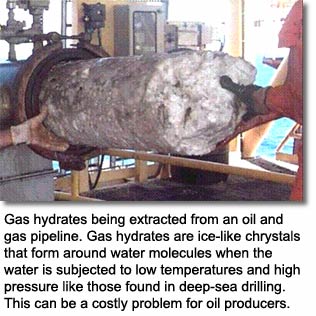Texas Tech University
Cracking a Wildcatter's Riddle
As long as 60 years ago, oilmen began noticing that their gas pipelines were being plugged by ice-like crystals even though temperatures had not dropped below freezing.
Decades later, scientists now know they aren’t dealing with ice at
all; the substance is actually a gas hydrate, or  crystallized compound
formed of water molecules and another substance – in this case the gas. Though
scientists have labored to eliminate or reduce this phenomenon, gas
hydrates remain an expensive thorn in the side of producers and have perplexed
researchers.
crystallized compound
formed of water molecules and another substance – in this case the gas. Though
scientists have labored to eliminate or reduce this phenomenon, gas
hydrates remain an expensive thorn in the side of producers and have perplexed
researchers.
“Where and how hydrates form is still unclear,” says Dr. Waylon House. “Many people are interested in how to predict and prevent them.”
House, an associate professor of petroleum engineering at Texas Tech, has turned to technology primarily used in medicine to deal with the challenge. Working with researchers at Rice University, House is using magnetic resonance imaging to predict hydrate formation in black oil emulsions.
If this approach proves effective, it could be a huge boon to the oil industry as it increasingly seeks to tap black gold at the bottom of the ocean.
Gas hydrates are the largest source of hydrocarbon known – and therefore a potentially huge source of energy, House says – but they can create financial and environmental conundrums for producers.
Drillers take a risk every time they go delving for the vast stores of natural gas along certain parts of U.S. shorelines, including the Gulf of Mexico. In those cold depths, eye-popping pressures and frigid temperatures create a catalyst for gas hydrates, which form around water molecules in the pipes and trap the gas in a veritable ice cage.
Imagine the gas molecules are eggs in a crate. Actually, imagine arranging eggs on a countertop and waiting for a crate to form around them, House says.
Now imagine taking that crate, shoving it into an underwater pipeline, and hoping it won’t jam as the pipe twists and turns its way across the ocean floor. That is how the hydrates behave, wreaking havoc on pipelines. Once they form, they rake a pipeline’s interior like BBs or clog it like plaque in an artery.
This can be very costly, especially since some rigs are capable of producing something like hundreds of thousands of barrels – or millions of dollars – per day.
 “These rigs are major sources of oil production and revenue,” he
says. “When you plug one of them up, it is a catastrophe.”
“These rigs are major sources of oil production and revenue,” he
says. “When you plug one of them up, it is a catastrophe.”
Even worse, most of these blockages form so deep that they can only be reached by remote submersibles. Producers combat this by pumping methanol into wellheads to absorb water, keeping the hydrates from forming. But this is costly and inefficient.
Knowing when and why the hydrates form is a better way to combat them, House says. There are certain oils that do not form hydrates, for instance, and scientists are still unsure about the exact point at which they form.
House began using the MRI technology because traditional hydrate study methods are stymied in black oil, which does not allow light through it and makes pressure testing difficult.
He is well positioned to do this. Texas Tech houses one of only a handful of MRI machines of its type in the world devoted to solving these types of engineering problems.
Using this, House hopes to crack this wildcatter’s conundrum for good.Cory Chandler
